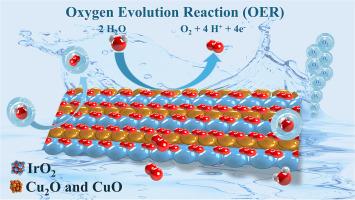铜氧化物与IrO2的掺入提高了析氧反应在中性和碱性条件下的稳定性
IF 5.6
3区 材料科学
Q1 ELECTROCHEMISTRY
引用次数: 0
摘要
开发高效稳定的析氧反应电催化剂仍然是一个重大挑战,特别是在不同的pH条件下。到目前为止,IrO2被认为是OER最有效的电催化剂之一,但它在高电流密度下往往会降解。一般来说,在一次催化剂中加入二次金属已被证明是提高水裂解电催化性能的有效途径。在这项工作中,我们提出了一种电化学合成的双金属Cu-IrO2电催化剂,与单独的IrO相比,它具有更高的OER活性和稳定性。在碱性介质中,300°C退火的Cu-IrO2显示出1.40 V vs RHE的起始电位和46 mV / 12的低Tafel斜率。以Cu氧化物的形式添加Cu和热处理的组合提高了催化剂的耐久性,在开关电解条件下进行了80小时的测试,降解最小。在中性pH条件下也发现了类似的增强。氧化铜掺杂的IrO 2活性的提高是由于增加了电化学活性表面和低电荷转移阻力,而耐久性的提高是由于在OER过程中保持了催化剂的结构和晶体完整性。本文章由计算机程序翻译,如有差异,请以英文原文为准。


Incorporating Cu oxides with IrO2 for improving the stability of the oxygen evolution reaction in neutral and alkaline conditions
Developing highly efficient and stable electrocatalysts for the oxygen evolution reaction (OER) remains a major challenge, especially under different pH conditions. IrO2 is renowned as one of the most efficient electrocatalysts for the OER, but it tends to degrade at high current densities. In general, incorporating secondary metals into primary catalysts has proven to be an effective way to enhance the electrocatalytic performance for water splitting. In this work, we present an electrochemically synthesized bimetallic Cu–IrO2 electrocatalyst that demonstrates enhanced activity and stability for the OER compared to IrO₂ alone. In alkaline media, Cu–IrO2 annealed at 300°C demonstrated an onset potential of 1.40 V vs RHE and a low Tafel slope of 46 mV dec–1. The combination of Cu addition, in the form of Cu oxides, and heat treatment increased catalyst durability with minimal degradation over 80 h of testing under on–off electrolysis conditions. Similar enhancements were also found under neutral pH conditions. The improved activity of Cu oxide–incorporated IrO₂ is attributed to increased electrochemically active surface and low resistance to charge transfer while the improved durability is attributed to maintaining the structural and crystalline integrity of the catalyst during the OER.
求助全文
通过发布文献求助,成功后即可免费获取论文全文。
去求助
来源期刊

Electrochimica Acta
工程技术-电化学
CiteScore
11.30
自引率
6.10%
发文量
1634
审稿时长
41 days
期刊介绍:
Electrochimica Acta is an international journal. It is intended for the publication of both original work and reviews in the field of electrochemistry. Electrochemistry should be interpreted to mean any of the research fields covered by the Divisions of the International Society of Electrochemistry listed below, as well as emerging scientific domains covered by ISE New Topics Committee.
 求助内容:
求助内容: 应助结果提醒方式:
应助结果提醒方式:


